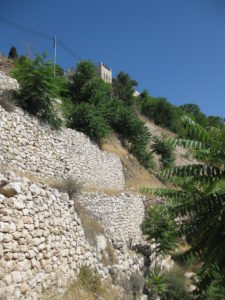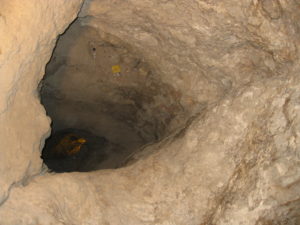After Saul’s death, the elders of Judah proclaimed David king in Hebron, and subsequently, the northern tribes also recognized him as king of Israel.
The second book of Samuel describes the capture of the city of Jerusalem by David’s troops: “Then the king and his men went to Jerusalem against the Jebusites who inhabited the land. They told David, “You shall not enter here: the blind and the lame will drive you away!” which was their way of saying, “David shall not enter here.” David nevertheless captured the fortress of Zion, which is the City of David. On that day David said: “All who wish to strike at the Jebusites must attack through the water shaft. The lame and the blind shall be the personal enemies of David.” That is why it is said, “The blind and the lame shall not enter the palace.’ David took up residence in the fortress which he called the City of David. David built up the city on all sides, from the Millo toward the center” (2 Samuel 5:6-9).

“Embankment”, in the City of David, Jerusalem, Wikicommons
In the excavations at the City of David in Jerusalem, a tunnel has been uncovered that connects the interior of the Jebusite city, through what is called “Warren’s Shaft,” to the Gihon Spring, which was located outside the walls and provided water for the city. Through this shaft and subsequent tunnel, it was possible to access the city’s interior even if the walls were well-protected. Today, you can still see part of the structure mentioned in the text, situated on the slopes of Ophel.

City of David Warren’s shaft, photo by Deror Avi
The conquest of Jerusalem was an event of considerable political and religious significance. Because until then it had been in the hands of the Jebusites, it did not belong to any of the Israelite tribes. Therefore, it was a neutral city, ideal for establishing the capital without favoring any particular tribe. Once the court was established there, a first attempt at centralizing worship was also made by moving the Ark to Jerusalem.
From then on, the city of Jerusalem occupies a central place in the Bible as a political and religious capital and, above all, as a theological symbol. The Lord reigned in Jerusalem, which became a holy city after the Ark was brought there and was elevated to be the dwelling place of God and the seat of the Davidic dynasty. Just as the Lord chose Israel to be His people and David to begin the dynasty, He also chose Jerusalem to be “the city of the Lord.” Thus begins the theological consideration of Jerusalem, which is exalted when the people remain faithful and destroyed when their infidelity brings the punishment of exile (6th century B.C.).
The holy city of Jerusalem, where Jesus completed His work of redemption, does not lose its prominence in the New Testament. The Kingdom of God, established by Jesus Christ, also sees in the new, celestial, and eschatological Jerusalem its ideal capital. The author of Revelation writes: “I heard a loud voice from the throne saying, “Behold, God’s dwelling is with the human race. He will dwell with them, and they will be his people, and God himself will always be with them [as their God]. He will wipe every tear from their eyes, and there shall be no more death or mourning, wailing or pain, [for] the old order has passed away” (Revelation 21:3-4).
By father Francisco Varo, priest
